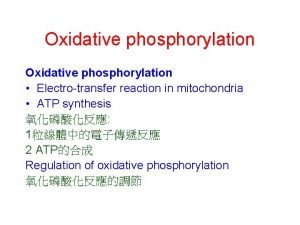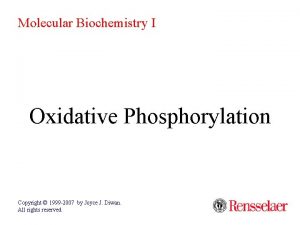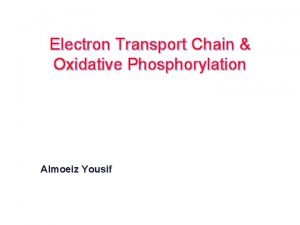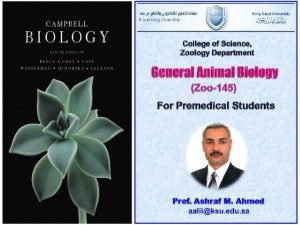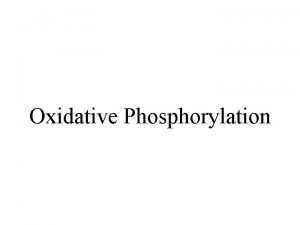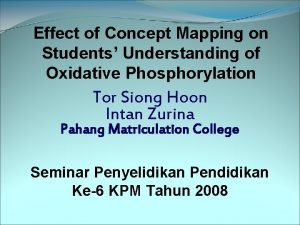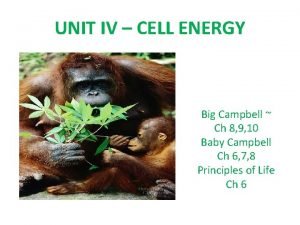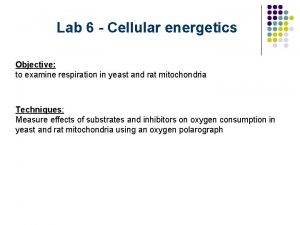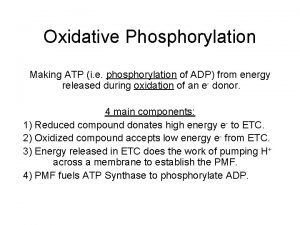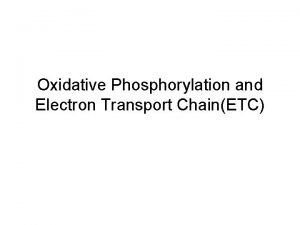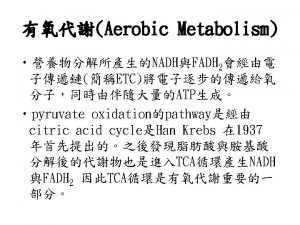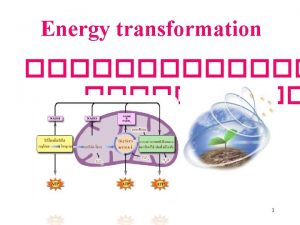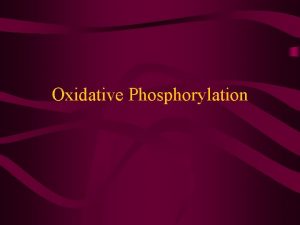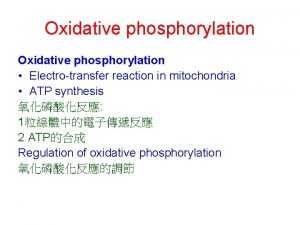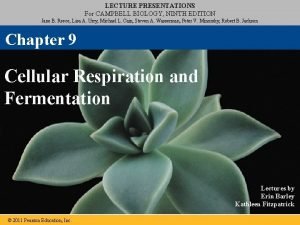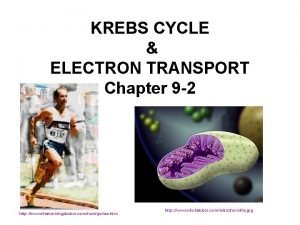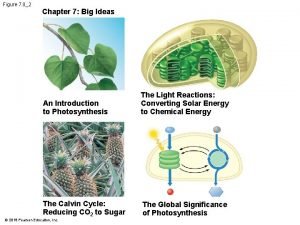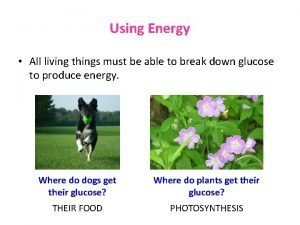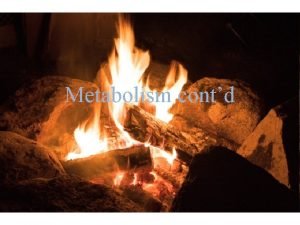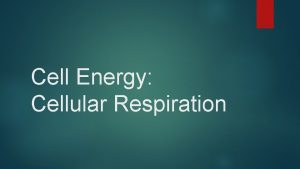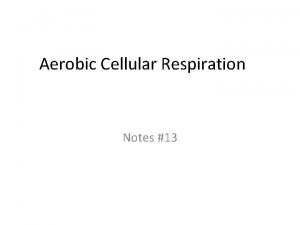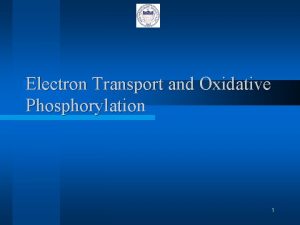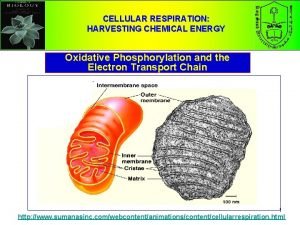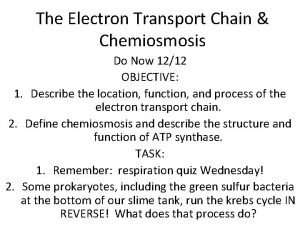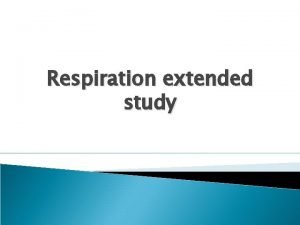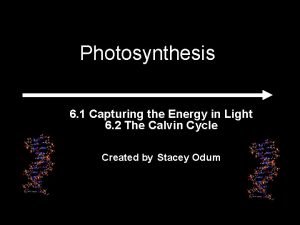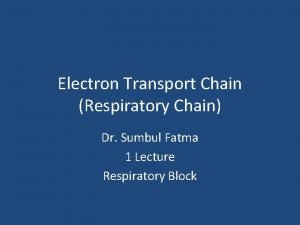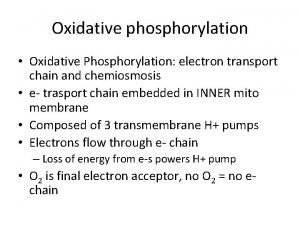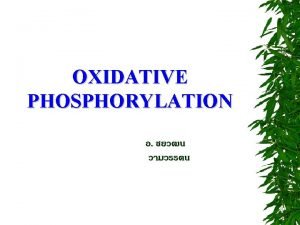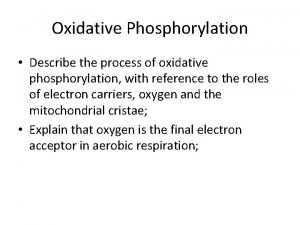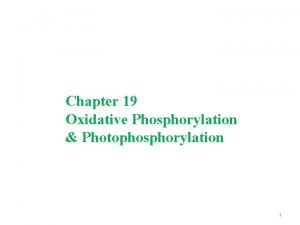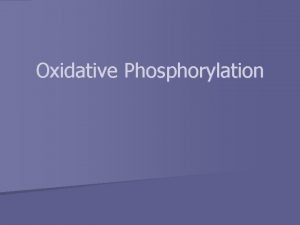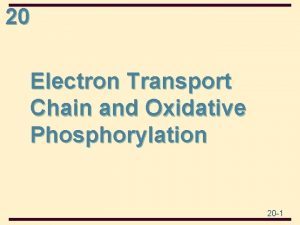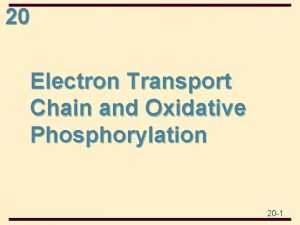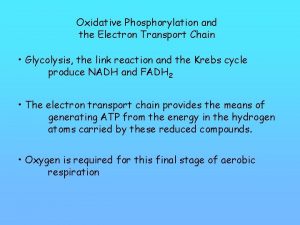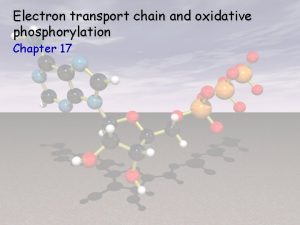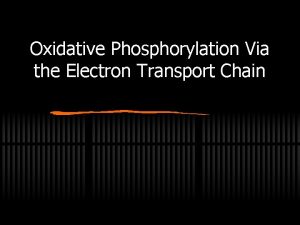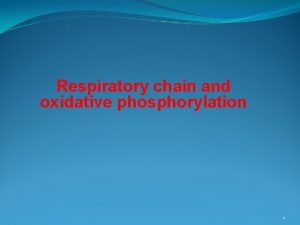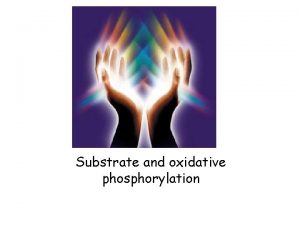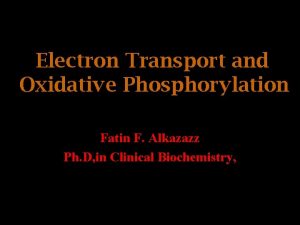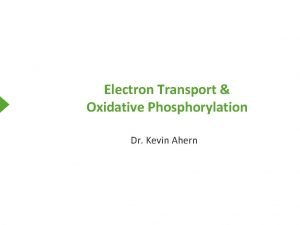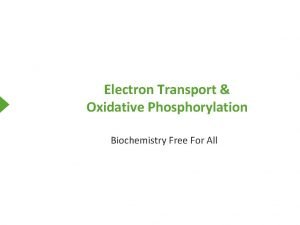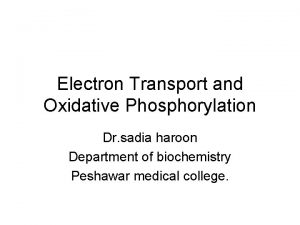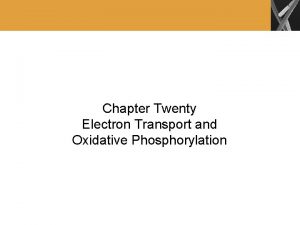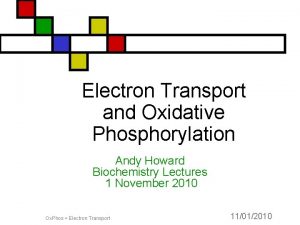Oxidative Phosphorylation AKA The Electron Transport Chain Inner






























- Slides: 30

Oxidative Phosphorylation AKA The Electron Transport Chain

Inner Mitochondrial Membrane Q: What structures increase the surface area of the mitochondrion? The IMM contains thousands of sets of ETCs. Each is a self -contained ATP making factory.

Where most of the ATP is made • Q: How many ATP were made prior to the ETC? • Q: By what method(s) were these made? • The rest (34 more) will all come from oxidative phosphorylation.

Return of NADH and FADH 2 • Remember all those electrons we put into NADH and FADH 2? They’re baaaaack… • Their job was to shuttle the energy from glycolysis, the intermediate step, and Krebs to the ETCs. – That’s why they are “electron carriers” • Q: How many NADH were made in each step? FADH 2?

Like UPS

Electrons are passed down the chain – from high to low energy • It is called a CHAIN because there are many links, each of which has the ability to receive and pass on electrons – they are ordered according to their energy level (descending) • Q: Why does it make sense to have electron carriers ordered by decreasing energy?


The panama canal


ATP synthase • An enzyme that catalyzes the reaction in which ATP is made from ADP and inorganic phosphate • Consists of many subunits – altogether looks like a windmill – has an axle and subunits that spin around • Has a membrane region and a matrix region

Like a windmill

Protons are the wind! • The enzyme is powered by the flow of protons through the enzyme across the Inner Mitochondrial Membrane. • This has to do with POTENTIAL ENERGY and the ELECTROCHEMICAL GRADIENT

Making the Grade-ient • The proton gradient is created by the chain itself – as electrons flow through the chain the protein complexes pump protons across the membrane from the matrix to the Intermembrane space. • This creates an electrochemical gradient…



Calculations • NADH vs. FADH 2 • NADH is oxidized by complex I • FADH 2 is oxidized by complex II • Q: what difference would this lead to?


Adding it all up… • • Q: How many ATP made via SLP? Q: How many NADH? Q: How many FADH 2? Q: How many ATP total?

38 or 36? Cell must ‘pay’ 2 ATP to transport the NADH from glycolysis into the mitochondrion. This can depend on the type of transporter so 38 is the ‘theoretical max’

I’m lying… 38 is actually an overestimate based on simplified ratios and maximum efficiency. So in your body it’s a bit less…

Applications • Some points of interest

Poisoning the Chain! • Cyanide and Carbon Monoxide both inhibit Protein Complex IV and prevent the transfer of electrons to Oxygen. AKA does not go down the chain. Q: what will be the ultimate effect of this inhibition?

Nasty Rootbeer!

Fermentation • In the absence of oxygen, anaerobic respiration will take place. This consists of glycolysis and a fermentative step 1. Fermentation does not produce more ATP, rather its purpose is to regenerate NAD+ from NADH so glycolysis can work • Q: What are the two types of fermentation?

Lactic Acid Fermentation • Takes place in bacteria and our own muscles. This purpose is to regenerate NAD+ • Pyruvate is converted to Lactic Acid instead of going to Acetyl Co. A

Alcoholic Fermentation • Pyruvate is converted to ethanol instead of Acetyl Co. A. This will regenerate NAD+ • Takes place in bacteria, yeast.

So the point of fermentation? (1) To make energy! Organisms/cells that are carrying out fermentation cannot do oxidative phosphorylation (ETC)– glycolysis is the only way they get energy (2) To regenerate NAD+! NAD+ is the fuel that allows glycolysis to proceed – if it is not regenerated than glycolysis shuts down


• Q: What is the ATP yield per glucose for organisms doing fermentation? Q: How does this compare to that of aerobic organisms?

The End… Get into groups – work on your 2 nd draft with the Essay Rubric and finish up any all review worksheet. This is not free time, finish up all your work. Everything due on Friday (and it’s a lot).
 Uncouple oxidative phosphorylation
Uncouple oxidative phosphorylation Uncouplers of oxidative phosphorylation
Uncouplers of oxidative phosphorylation Slidetodoc.com
Slidetodoc.com Substrate level phosphorylation vs oxidative
Substrate level phosphorylation vs oxidative Uncouplers of oxidative phosphorylation
Uncouplers of oxidative phosphorylation Accomplish the concept map on redox reaction
Accomplish the concept map on redox reaction Oxidative phosphorylation enzymes
Oxidative phosphorylation enzymes Oxidative phosphorylation energy yield
Oxidative phosphorylation energy yield Oxidative phosphorylation
Oxidative phosphorylation Energetics of oxidative phosphorylation
Energetics of oxidative phosphorylation Inhibitors of oxidative phosphorylation
Inhibitors of oxidative phosphorylation Inhibitors of oxidative phosphorylation
Inhibitors of oxidative phosphorylation Uncouplers of oxidative phosphorylation
Uncouplers of oxidative phosphorylation Oxidative phosphorylation
Oxidative phosphorylation Define oxidative phosphorylation
Define oxidative phosphorylation Atp synthesis
Atp synthesis Inner critic and inner defender
Inner critic and inner defender Fermentation
Fermentation Glycolysis vs krebs cycle
Glycolysis vs krebs cycle Vertical
Vertical Electron transport chain cellular respiration
Electron transport chain cellular respiration Where does the krebs cycle take place?
Where does the krebs cycle take place? Catabolism
Catabolism Electron transport chain cellular respiration
Electron transport chain cellular respiration What does aerobic respiration mean
What does aerobic respiration mean Electron transport chain
Electron transport chain Cellular respiration harvesting chemical energy
Cellular respiration harvesting chemical energy Chemiosmosis
Chemiosmosis Significance of electron transport chain
Significance of electron transport chain Labelled
Labelled Components of electron transport chain
Components of electron transport chain
